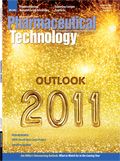Colloids Book Helps and Confuses the Reader
Poor organization makes it hard for readers to find the helpful information in a recent book.
The field of colloids, or pseudosolutions, has advanced to the point that a volume dedicated to the specific uses of this diverse group of materials is warranted. The editor of Colloids in Drug Delivery defines colloids as "a dispersion of one phase in another with size ranging from 1 nm to 1 μm." A better definition might be that colloids include long-chain hydrocarbons (e.g., surfactants, dendrimers, and polymers) that can be formulated to create micelles, liposomes, and stable emulsions.

Colloids in Drug Delivery, Edited by Monzer Fanun, Ed., CRC Press, Boca Raton, FL, 2010, 652 pp., ISBN: 9781439818251
When used correctly, colloids can change significantly the microenvironment that determines many of the physical characteristics of a drug in solution. Scientists currently use colloids to make microemulsions, microshperes, nanoparticulates, liquid crystals, and other unique drug-delivery systems. Colloidal systems have been employed for many years, but the growth in importance of the micro- and nanodispersions, and the growth in the field itself, calls for a comprehensive text to ensure that formulators are taking advantage of all the capabilities available to them.
This text delivers on the promise of being comprehensive. The book is 626 pages long and includes nearly 1000 references. Chapters range from general topics, such as surfactants and block copolymers, to specific focuses, such as poly(alkyl cyanoacrylate) nanoparticulates for drug delivery and vaccine development.
The book's ambitious scope required the editor to bring together acknowledged experts in the field under strong editorial direction to ensure coherence among the chapters. Once again, the book delivers with well-written chapters and excellent, context-appropriate figures, tables, and illustrations provided by recognized experts in the field. The editor clearly expended a great deal of effort to ensure that the publication was well edited and consistent in tone and presentation.
Unfortunately, the organization of the chapters and the level of detail that they provide make the book difficult to use. To be a solid resource for formulators to learn about advances in the field, the book's early chapters should be broad overviews that describe the basics in general terms, thus allowing novices to become well-versed in the relevant concepts before they are introduced to advanced ideas.
The first chapter does a good job of defining the scope of the field by including sections about surfactants, surfactant-based micelles, block-copolymers, and liquid-crystals. But it moves on to describe, too briefly, the application of each of type of colloid to specific dosage-form challenges.
This chapter leads the reader to expect subsequent chapters focused on each dosage form and on potential approaches to potential challenges. Instead, the following chapters focus on how the types of colloids could be used in drug delivery. This organization leads to repetitious sections in many chapters, such as "Applications of liquid crystals in drug delivery: Ointments and creams" in Chapter 13, "Self-microemulsifying drug-delivery systems for topical delivery" in Chapter 10, and "Applications of multiple emulsions in pharmaceutical and biotechnological fields: Topical and transdermal delivery" in Chapter 8.
All of these chapters present information about the applications of the specific colloid to a dosage form. A more usable organization would have divided the text into sections about various dosage forms. Each section could have listed all of the colloids that had been used, explained why they were used, and related their expected benefits and drawbacks. As the book stands, a formulator trying to determine how to use a colloid to solve a problem with a formulation would have to open every chapter, read its table of contents, read the section and try to determine which option provided the greatest opportunity. A formulator working with a tricky cream or ointment will find it difficult to survey all of the options available.
Overall, the high caliber of the book should make it exceptional as a reference text if the reader wants to know more about a specific type of colloid. The rich reference section and good illustrations can help the reader initiate an in-depth study. If the reader is looking for a text to guide him or her in selecting a colloid to solve a difficult formulation problem, however, then he or she should look somewhere else.
Todd Cecil is vice-president of compendial sciences at the US Pharmacopeia, 12601 Twinbrook Pkwy., Rockville, MD 20852-1790, tel. 301.816.8234, tlc@usp.org He also is a member of Pharmaceutical Technology's editorial advisory board.

Drug Solutions Podcast: A Closer Look at mRNA in Oncology and Vaccines
April 30th 2024In this episode fo the Drug Solutions Podcast, etherna’s vice-president of Technology and Innovation, Stefaan De Koker, discusses the merits and challenges of using mRNA as the foundation for therapeutics in oncology as well as for vaccines.
PacBio Chosen as Tech Partner for Global Alzheimer’s Disease Research Project
April 23rd 2025The project, the North African Dementia Registry, will unite multiple entities for the purpose of developing a comprehensive dataset to advance the research community’s understanding of Alzheimer’s disease and other dementias in diverse populations.